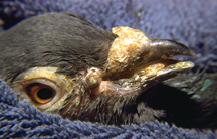Pox Virus Infection in Birds
General Information
Poxviruses can infect many species of birds, and each species of bird may have its own unique species of pox virus (mynah bird pox, canary pox, parrot pox, etc.). Poxviruses can cause several different clinical syndromes, depending upon what part of the body is infected.
What are the signs of a poxvirus infection?
There are several distinct clinical syndromes seen in birds infected with a poxvirus. In the cutaneous (skin) form of the disease, nodular or crusted areas of the non-feathered skin are seen. These lesions most often occur around the face and on the feet, beginning as white or yellow areas that rapidly progress to form crusts. In lovebirds, poxvirus lesions often appear on darkened or discolored areas of the skin. In the diphtheritic (respiratory) form of a poxvirus infection, thickened plaques occur in the mouth, throat, or sinuses; these lesions may occur by themselves or with skin lesions.
Canary pox may present as sudden death or the sudden onset of difficult breathing.
How is poxvirus diagnosed?
"Diagnosis is made by a biopsy of the lesion."
While the skin lesions and plaques that occur in poxvirus infection can suggest a poxvirus infection, abscesses, tumors, and bacterial or fungal diseases may look similar. Diagnosis is made by a biopsy of the lesion; it may be sometimes be possible to isolate the virus from the lesions.
How is poxvirus transmitted?
Poxviruses require an injury to enter the body. Most commonly, mechanical vectors such as mosquitoes and biting flies transmit the virus from an infected bird to a non-infected one. Birds that are housed outdoors are therefore more susceptible than those kept indoors. Remember that mosquitoes and flies can come indoors as well. The virus can also be transmitted by ingestion of infected scabs or inhalation of aerosols.
How is poxvirus treated?
Control of mosquitoes and flies is critical if birds are housed outdoors. The best control is prevention; raise your birds indoors and use insect proof screening. Many birds will recover with supportive treatment; local treatment of the crusts may be indicated. Antibacterial therapy is often used if a secondary bacterial infection is present. Healthy birds can be vaccinated, although this is most typically done for birds living in a flock rather than an isolated household pet.






